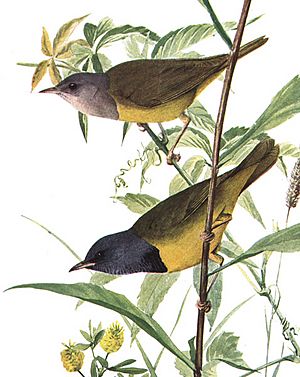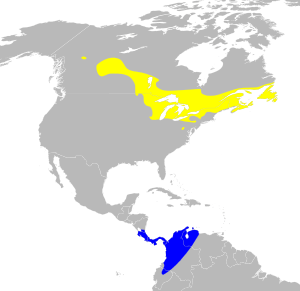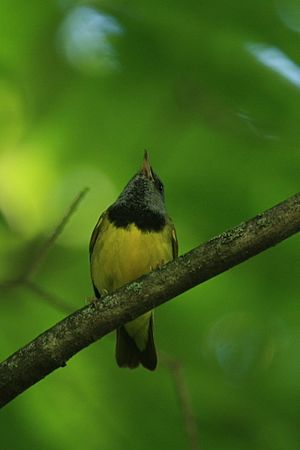Mourning warbler facts for kids
Quick facts for kids Mourning warbler |
|
|---|---|
 |
|
| Mourning warbler by Louis Agassiz Fuertes | |
| Conservation status | |
| Scientific classification | |
| Genus: |
Geothlypis
|
| Species: |
philadelphia
|
 |
|
| Range of G. philadelphia Breeding range Wintering range | |
| Synonyms | |
|
Oporornis philadelphia |
|
The mourning warbler (Geothlypis philadelphia) is a small songbird. It belongs to the New World warbler family. These birds live in eastern and central North America. They also live in some parts of Central America.
Mourning warblers are known as "neotropical migrants." This means they travel long distances between their breeding and winter homes. They often live in thick, new forests that are growing back. They are part of a group called Wood-warblers. These are colorful birds that live in trees or on the ground.
Wood-warblers are in the order Passeriformes. This group includes more than half of all bird species. These birds are often called "perching birds." The mourning warbler's family, Parulidae, also includes birds like the Common Yellowthroat and the American Redstart. Mourning warblers look a lot like the MacGillivray's warbler. This is especially true for females and young birds. However, their breeding areas do not overlap.
The name "mourning" comes from the male bird's gray hood. People thought it looked like a veil worn during mourning.
Contents
What Does a Mourning Warbler Look Like?
Mourning warblers are small songbirds. They have yellow feathers on their belly. Their upper parts are olive-green. They have a thin, pointed beak and pink legs.
Adult male mourning warblers have a gray hood. They also have black patches around their eyes and on their throat and chest. In the fall, these colors become less bright. This makes them harder to tell apart from similar birds. But they never have a broken eye ring.
Female and young mourning warblers have a gray-brown head. They have an eye-ring that is not complete. Their throat is yellow-gray. Their chest has a brown or olive tint.
Both male and female birds are about 10 to 15 centimeters (3.9 to 5.9 inches) long. They weigh about 11 to 13 grams (0.4 to 0.5 ounces). Their wings can spread about 18 centimeters (7.1 inches) wide.
Other birds that look similar include the Connecticut warbler. This bird has a complete eye ring. Young Connecticut warblers also have a whiter chest. Young mourning warblers have a yellow chest. Nashville warblers are also often confused with them. However, Nashville warblers have a yellow throat. Mourning warblers have black or gray throats. Nashville warblers are also smaller and less active.
Where Do Mourning Warblers Live?
Mourning warblers breed in southern Canada. During migration, they are often seen in the central and eastern United States. They also visit countries like Belize, Puerto Rico, and Panama.
These birds migrate to Central America and northern South America for the winter. Mourning warblers build their nests low to the ground. They prefer forests that have been disturbed. These areas usually have thick bushes and a covered tree canopy. In winter, they like wet, low-lying areas with lots of plants.
Mourning Warbler Behavior and Life
What Do Mourning Warblers Eat?
Mourning warblers look for food low in plants. Sometimes, they catch insects while flying. They mostly eat insects. They also eat some plant material. This includes fruits from the Cecropia tree in winter.
Their diet is not fully known. But it also includes insect larvae and spiders. They pick these from the branches of shrubs. They are also known to remove the legs and wings of insects before eating them.
Mourning Warbler Reproduction
Mourning warblers breed in southern Canada. Their breeding areas are thickets and open spaces. These spots have dense shrubs. They are found across Canada east of the Rockies. They also breed in the northeastern United States.
The nest is an open cup. It is placed on the ground in a hidden spot. It is usually under thick shrubs or other plants. Their nest is often made of grass, leaves, and bark. It is lined with roots or other thin materials.
Mourning warblers usually lay 2 to 5 eggs. The eggs are white or have brown and black speckles. The eggs hatch after about 12 days. Both male and female adults use a trick to protect their nest. They pretend to have broken wings to distract predators. Young mourning warblers have gray tufts of feathers on their heads. Their mouths are red. Female adults have been seen eating their eggs after the young hatch. The young birds leave the nest after 7 to 9 days.
Mourning Warbler Sounds
The song of this bird is a bright, repeated warble. The song has rolling sounds that usually get quieter at the end. It can sound like "chirry, chirry, chirry, chorry, chorry." Their call is a sharp chip. They usually have two different pitched calls. One is higher than the harsh chip sound.
Mourning Warbler Conservation
The number of mourning warblers has gone down. The North American Breeding Bird Survey shows a drop of about 43% in the last 50 years. However, they are still listed as a species of "least concern." This means they are not currently in danger. Partners in Flight estimates there are 17 million breeding birds worldwide.
Mourning warblers prefer disturbed forests. This means they might actually benefit from human activities. These activities can sometimes harm the homes of other bird species.
See also
 In Spanish: Chipe cabecigrís filadélfico para niños
In Spanish: Chipe cabecigrís filadélfico para niños



